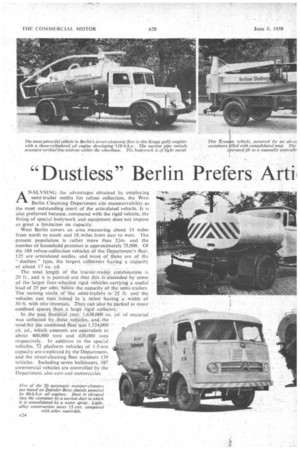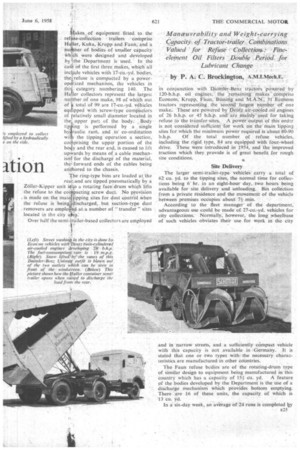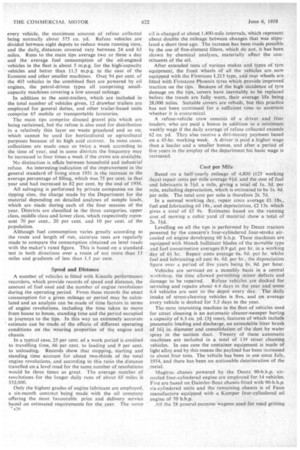"Dustless" Berlin Prefers Arti Ition
Page 68

Page 69

Page 70

Page 71

If you've noticed an error in this article please click here to report it so we can fix it.
by P. A; C. Brockington,
ANALYSING the advantages' obtained by employing •L'‘,semi-trailer outfits for refuse collection, the West Berlin Cleansing Department cite manteuvrability as the most outstanding merit of the articulated vehicle. It is also preferred because, compared with the rigid vehicle, the fitting of special bodywork and equipment does not impose as great a limitation on capacity.
West Berlin covers an area measuring about 19 miles from north to south and 18 miles from east to west. The present population is rather more than 21-m. and the number of household premises is approximately 75,000. Of the 169 refuse-collection vehicles of the Department's fleet. 125 are articulated outfits, and most of theSe are of the " dustless" type, the largest c011eetors having a capacity of about 17 cu. yd. . . , The total length of the "tractor-trailer combination is 29 ft., and it is pointed out that this is exceeded by some of the larger four-wheeled rigid vehicles. carrying a useful load of 25 per cent below the capacity of the semi-trailers The turning circle of the semi-trailers is 25 ft. and the vehicles can turn round in a .Street having a width of 30 ft. with two reversals. They can also be 'parked in more confined spaces than a large rigid collector..
In the past financial year, 1,638,000 Cu. yd. of material was collected by these vehicles, and the total-for the combined fleet was '1,724,000 cu. yd., which amounts are equivalent to about 400,000 tonand 420,000 tons respectively. In addition to the special vehicles, 72 platform vehicles of 1-5-ton capacity are employed by the Department. and the street-cleaning fleet numbers 139 vehicles. Including seven bulldozers, 387 commercial vehicles are controlled by the Department, also cars and motorcycles. akes of equipment fitted, to the ref Se-collection • trailers eanprise
Kuka, Krupp and 'Faun, and .a nutAber of bodies of 'smaller capacity WNeh were Ldesigned and -developed by f the -Department is used. In the cab of the first three Makes, which all inctiude vehicles with 17-6.1.-yri. bodies, thcirefuse is• compacted by a poweropei;rated mechanism, the vehicles in thilcategory numbering 140. The Hailer collectors represent the largest number of one make, 98 of whieh out of total of 99 are 17-cu.-yd. vellieles eqtfipped with Screw-type compactors. of celatively small diameter located in the .upper part of the body. Body tipping is performed by a single hy raulic rain, and in co-ordination wii the tipping operation a section, comprising the upper portion of the bo y and the rear end, is caused to lift .upwards by means of .a cable meebanisnur for the discharge of the material, the; forward ends of the cables being anghored to the chassis.
1"he ring-type bins are loaded at the rearAnd are tipped pneumatically by a ZiiIler-Kipper unit it a rotating face drum which lifts the refuse to the coacting screw duct. No provision . is made on the main ipping sites for dust control when the refuse is bein ischarged, but suction-type dust removers are ernplo..4 at a number of " transfer " sites located in the city 49.
. Over half the semi-trailer-based collectors are ertiployed
in conjunction with f)airnter-Benz tractors pOwered by 120-b.h.p. oil engines; the :remaining makes comprise Econom, Krupp, Faun, Bitssing and M.A.N., 31 .Econorn tractors representing the Second largest number of one make: These are powered by Deutz air-cooled oil engines of 26 b.h.p. or 45 b.h.p. and are mainly used for taking refuse to the transfer,sites. A power output of this orthr is not .considered sufficient for work on the main tipping sites for which the minimum power required is about 80-90 b.h.p. Of the total number of refuse vehicles, including the rigid type, 84 are equipped with four-wheel drive. These were introduced in 1954, and the improved traction which they provide is of great benefit for rough site conditions.
Site Delivery The larger semi-trailer-type vehicles carry a total of 62 Cu. yd. to the tipping sites, the normal time for collections being 6hr. in an eight-hour day, two hours being available for site delivery and unloading. Bin collection from a private residence and the.movernent of the vehiele between premises occupies about 74 min.
According to the fleet manager of the department, advantageous use could be made of 27-cu.-yd. vehicles for • city collections. Normally, however, the long wheelbase of such vehicles obviates their use for work in the city
and in narrow streets, and a sufficiently compact vehicle with this capacity is not available in Germany. It is stated that one or two types with the necessary characteristics are manufactured in other countries.
The Faun refuse bodies are of the rotating-drum type of similar design to equipment being manufactured in this country which has a capacity of 15A cu. yd. A feature of the bodies developed by the Department is the use of a discharge mechanism which provides bottom emptying. There are 16 of these units, the capacity of which is 13 eu. yd. • In a six-day week, an average of 24 runs is completed lu a25 every vehicle, the maximum amount of refuse collected being normally about 375 cu. yd. Refuse vehicles are divided between eight depots to reduce waste running time, and the daily, distances covered vary between 24 and 63 miles. Runs to the main tips average two or three a day and the average fuel consumption of the oil-engined vehicles in the fleet is about 5 m.p.g. for the high-capacity vehicles and better than 11.5 m.p.g. in the case of the Econom and other smaller machines. Over 94 per cent. of the 403 vehicles in the combined fleet are powered by oil engines, the petrol-driven types all comprising smallcapacity machines covering a low annual mileage.
In addition to the senii-trailers, which are included in the total number of vehicles given, 12 drawbar trailers are employed for general duties, and other trailer-based units comprise 65 mobile or transportable lavatories.
The main tips comprise disused gravel pits which are being reclaimed, but the refuse is also used for distribution in a relatively thin layer on 'waste grassland and so on, which cannot be used for horticultural or agricultural purposes because of its high acid content. In most cases, collections are made once or twice a week according to the time of year, and in some districts the frequency may be increased to four times a week if the crews are available.
No distinction is nitde between household and industrial refuse. Art interesting indication of the improvement in the general standard of living since 1951 is the increase in the average percentage of filling, which was 75 per cent. in that year and had increased to 82 per cent. by the end of 1956.
All salvaging is performed by private companies on the tipping sites, the charge made by the Department for the material depending on detailed analyses of sample loads, which are Made during each of the four seasons of the year. Districts are classified in the three categories, upper class, middle class and lower class, which respectively represent 70 per cent., 20 per cent. and 10 per cent. of the population.
Although fuel consumption varies greatly according to the route and length of run, accurate tests are regularly made to compare the consumption obtained on level roads with the maker's rated figure. This is based on a standard. test in both directions over a route of not more than 13 miles and gradients of less than 1.5 per cent.
Speed and Distance A number of vehicles is fitted with Kienzle performance recorders, which provide records of speed and distance, the amount of fuel used and the number of engine revolutions during the operating period. From these records the exact consumption for a given mileage or period may be calculated and an analysis can be made of time factors in terms of engine revolutions, including the time taken to move from house to house, standing time and the period occupied in journeys to the tips. In this way an extremely accurate estimate can be made of the effects of different operating conditions on the wearing properties of the engine and chassis. :
In a typical case, 25 per cent. of a work period is credited to travelling time, 66 per cent. to loading and 9 per cent. to unloading. ReCords show that stopping, starting and standing time account for about two-thirds of the total engine revolutions, and according to this ratio the distance travelled on a level road for the same number of revolutions would be three times as great. The average number of revolutions for the longer daily runs of about 65 miles is 332,000.
Only the highest grades of engine lubricant are employed, a six-month contract being made with the oil company offering the most favourable price and delivery service based on estimated requirements for the year. The sump ' F26 oil is changed at about 1,400-mile intervals, which represent about double the mileage between changes that was stipulated a short time ago. The increase has been made possible by the use of fine-element filters, which do not, it has been shown by chemical analyses, materially affect the constituents of the oil.
After extended tests of various makes and types of tyre equipment, the front wheels of all the vehicles are, now equipped with the Firestone L213 type, and rear wheels are fitted with Firestone Phoenix tyres which provide improved traction on the tips. Because of the high incidence of tyre damage on the tips, covers have inevitably to be replaced before the treads are fully worn, their average life being 28,000 miles. Suitable covers are rebuilt, but this practice has not been continued for a sufficient time to ascertain whether it is economical.
A refuse-vehicle crew consists of a driver and four loaders, who are paid a bonus in addition to a minimum weekly wage if the.daily average' of refuse collected exceeds 62 Cu. yd. They also receive a dirt-money payment based on a 45-hr. working week. A driver is paid a higher wage than a loader and a smaller bonus, and after a period of live years in the employ of the department his basic wage is increased.
Cost per Mire Based on a half-yearly mileage of 4,800 (125 working days) repair costs per mile average 91d. and the cost of fuel and lubricants is 54d. a mile, giving a total of ls. 3d. per mile, excluding depreciation, which is estimated to be Is. 4d. per mile. The total cost per mile is therefore 2s. 7d.
In a normal working day, repair costs average 18s., fuel and lubricating oil 18s., and depreciation, £2 13s. which gives a total of £5 9s. Estimates based on the running cost of moving a cubic yard of material show a total of 2s. 3+d.
Levelling on all the tips is performed by Deutz tractors powered by the concern's four-cylindered four-stroke aircooled oil engine developing 60 b.h.p. These machines are equipped with Menek bulldozer blades of the movable type and fuel consumption averages 0.9 gal. per hr. in a working day of 6 hr. Repair costs average 6s. 9d. per hr. whilst fuel and lubricating oil cost 4s. 4d. per hr., the depreciation figure over a period of five years being 8s, 9d. per hour.
Vehicles are serviced on a monthly basis in a central workshop, the time allowed permitting minor defects and damage to be repaired. . Refuse vehicles are docked for servicing and repairs about 4.4 days in the year and some 6.4 vehicles are sent to the depot every day. The daily intake of street-cleaning vehicles is five, and on average every vehicle is docked for 5.3 days in the year.
The most interesting machine in the fleet of vehicles used for street-cleaning is an automatic cleaner-sweeper having a. capacity of 6.3 Cu. yd. (3+ tons), features of which include pneumatic loading and discharge, an extendable litter brush of 161 in. diameter and consolidation of the dust by water spray in the suction duct. Twenty of these automatic machines are included in a total of 139 street cleaning vehicles. In one case the container equipment is made of light alloy and by this means the payload has been increased to about four tons. The vehicle has been in. use since July, 1954. 'and there has been no noticeable deterioration of the metal.
Magirus chassis powered by the Deutz 90-b.h.p. aircooled four-cylindered engine are employed for 14 vehicles. Five are based on Daimler-Benz chassis fitted with 90-b.h.p. six-cylindered units and the remaining chassis is of Faun manufacture equipped with a Kamper four-cylindered oil engine of 70 b.h.p.
All the 28 general-purpose wagons used for road gritting in the winter, snow clearanee and so on, are based on Daimler-Benz Unimog vehicles powered by four-cylindered oil engines developing 25 b.h.p. The extent to which lightweight chassis .fitted with low-powered air-cooled oil engines are eriployed in the interests of economy, is shown by the number of lEconom vehicles in the fleet, which are exclusively used for street sweeping, washing and sprinkling and for the collection of consolidated mud. Smallest of these machines, the sweepers, are equipped with Deutz singlecylindered oil engines with an output of 15 b.h.p., the fuel return of which is 19 m.p.g. when the machine is sweeping at an average speed of 5 m.p.h with many stops.
The remaining Econom machines are powered by Deutz twin-cylindered 28-b.h.p. units, and vehicles' equippedfor
road sprinkling normally average 21 m.p.g. As rOadwashing machines, similar vehicles consume fuel at a rate of 19 m.p.g. when operating at about 7 m.p.h. In comparison, the Daimler-Benz 90-b.h.p. collector-sweepers average 51 m.p.g. when travelling between 5-6 m.p.h.
Of the 83 Econom vehicles, 27 are street sweepers, 28 are used for street washing, 19 are sprinklers and nine are fitted with jib-type hoists and open containers for collecting consolidated mud. Use of these low-powered vehicles restricts the speed of operation and they are not suitable for hilly routes but their favourable fuel consumption is an important factor in the overall economy of fleet operation.
Stationary Running
Mileages at which. the lubricating oil is changed are reduced in proportion to the length of time the engine is operating with the vehicle stationary. If there is negligible standing time, the oil is changed after 1,900 miles. The engines of the mud-collecting machines are drained and replenished at half this mileage and the lubricant of the sewage-wagon units is changed after the vehicle has covered 1,200 miles.
Berlin is noted for the large number of trees in' the suburban areas and the collection of dead foliage from September to November requires special measures. The leaves are swept into heaps by hand and are loaded into collecting vehicles by means of suction equipment developed for this particular job, the general principle being similar to that of a domestic vacuum cleaner. During the autumn of 1957, 31,000 cu. yd. of foliage were removed from the streets in 6,000 vehicle runs. The removal of anti-frost surfacing material from the streets in the winter months is complicated by its composition, which includes earth, chaff and so on. A' substantial proportion of the material is collected by the Econorn vehicles equipped with a Crane hoist and the remainder is removed from the gullies. From September, 1957, to February, 1958, approximately 14,300 cu. yd. of material were used for the roads.
In a normal week, 290 gullies are emptied by the six gully-emptying machines based on five Krupp chassis, . powered by three-cylindered 110-b.h.p. oil engines and a Faun chassis having a 70-b.h.p. four-cylindered -oil engine. Most of the vehicles in the street-cleansing fleet are relatively new machines and have covered less than 50,000 miles. Tyres .have yet to be reviewed and it is confidently expected that this will not become necessary until a mileage of well over 60,000 has been completed.
Transfer of Crews
The vehicles operate in two shifts from 6 a.m. to 2.30 p.m., and from 1.30 p.m. to 10 p.m., the overlapping period of one hour being ample for the transfer of crews and so on. Streets are divided into five categories in terms of weekly cleaning frequency: the business streets are cleaned from nine to 12 times, whilst the business-residential areas are visited between six and nine times. The number of operations in the case of thickly populated districts is from three to six, and streets with a reduced population density are cleaned once or twice during the week. .
Including running costs, depreciation and expenditure on brush renewals, the overall cost of street cleaning with the automatic sweeper-cleaner is approximately £1 7s. 6d. per cu. yd. of street refuse, of which 6.4 per cent. represents brush costs. The operating cost per working day, per mile travelled and per working mile, are given as £9 8s., 2s. 8d.
and 4s. 10d. respectively.
In the case of the gully-emptiers, the cost per working mile is 3s. 6d., whilst the mud-crane wagon costs about 3s. le mile to run. In terms of the cost per cu. yd. of material collected, the gully-emptier shows a saving, however, of nearly 40 per cent. Of the remaining vehicles in the streetcleansing fleet, the lorries are operated for a cost of approximately 8s. 9d. per mile, the sprinklers 1 ls. 7d., the street-washing vehicles 9s. 9d., and the refuse wagons 10s. 3d. The sewage collectors cost 6s. 4eper mile to run.








































































































































